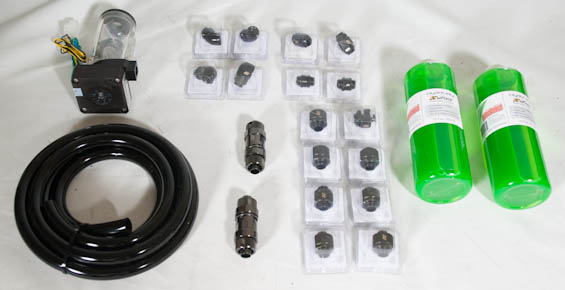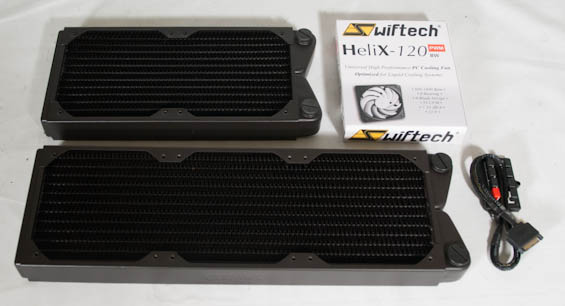The Neophyte's Custom Liquid Cooling Guide: How To, Why To, What To Expect
by Dustin Sklavos on September 30, 2013 12:01 AM ESTWith solid air cooling performance tested, it's time to make the jump to liquid cooling. It's very easy to be intimidated by the hardware involved, but let's break down what Swiftech graciously provided (and they provided quite a bit) and understand what these individual parts represent.

The top left of the photo above is Swiftech's combination MCP35X pump and reservoir, pre-assembled. The MCP35X pump is powered by a 4-pin molex connector, but can run at a variable speed controlled through an additional PWM header. Below it is six feet of very thick black TruFlex PVC tubing. The two large chrome parts to the right of it are no-spill, quick-release couplings designed to be in the middle of the tubing to allow you to disconnect parts of the loop as needed; these use what are called compression fittings. Speaking of which, the bulk of the parts in the surrounding plastic cubes are compression fittings, with 45-degree and 90-degree adapters floating around, along with multi-GPU connectors. Finally, the two bottles are Swiftech's HydrX PM (pre-mixed) coolant.
We're talking about watercooling, so what's in the coolant? Water is actually absolutely excellent at absorbing and carrying heat and has a tremendous heat capacity (think about how long it takes a pot of water to boil); the HydrX PM is actually 90% distilled water (which contains no impurities) and a mixture of chemicals to prevent algae and corrosion. This is very similar to how coolant/anti-freeze works in your car; water carries heat very well, but is also corrosive, so chemicals are introduced into the mixture to counteract that effect.

Next are the radiators. The radiators are made out of copper with brass tubing, and Swiftech carries two different types: one with a normal fin density designed for low speed fans (these), and one with a higher fin density designed for high speed fans. Higher fin density means improved surface area which in turn means superior heat dissipation, but more powerful fans are required to really push air through a denser radiator. For this build, there's one 360mm radiator and one 240mm radiator. Next to them is one of the five Helix-120 PWM-controlled fans intended to be used with the radiators, and the odd-looking dongle is actually a SATA-powered PWM-splitter.










106 Comments
View All Comments
Sadrak85 - Monday, September 30, 2013 - link
And one more thing is the addition of onboard voltage regulation, which is a lossy process almost by definition. Meaning, even with the better TIM, I seriously have my doubts that the thermals could hit the level of IVB or SB. Unless Intel somehow has some magic way of using the voltage and amperage they're scrubbing off.*small note, a good motherboard input, in terms of electricity, would pass through the filters pretty cleanly, but because Intel sets the specifications for the input, I have my doubts that they require such a thing, since the feature they added to their chip was to save money for the motherboard vendor.
leafonwind - Monday, September 30, 2013 - link
The thermal interface material is minor compared to the interface distance. Thermal resistance is L/kA. Going from a millimeter of thermal paste to an 10 micron gap (typical of paste when applied correctly) will give a 50x improvement. The difference in k between a good thermal paste and a bad thermal paste is typically a 5x difference unless you get into exotic materials like cadmium. http://forums.anandtech.com/showthread.php?t=22618...gandergray - Tuesday, October 1, 2013 - link
To bolster Von's point, see the work performed by Idontcare: http://forums.anandtech.com/showpost.php?p=3405318... .merikafyeah - Monday, September 30, 2013 - link
Super tiny correction: While it is true that liquids draw away heat much better than air, one must be cautious not to mistake water as a good CONDUCTOR of heat, aka something that "transfers" heat very well. Water is in fact an INSULATOR of heat, aka something that "absorbs" heat very well.merikafyeah - Monday, September 30, 2013 - link
Note wording on first page, third paragraph.ShieTar - Monday, September 30, 2013 - link
Correct, but to be precise, neither air nor water will conduct heat quickly enough for PC cooling purposes, both are only used to absorb the heat before being transported away from the heat source.Which makes you wonder how a closed-loop, compressed air cooling system would fare against a water-cooling system. Heat capacity might still be lower for air than for water, even at increased pressures, but I assume that you can produce higher flow rates for a compressed gas than for a liquid. And you could use the required compressor in order to:
1) Reduce the air temperature below room temperature before sending it to the heat sources.
2) Increase radiator temperature over the CPU/GPU temperatures, thus achieving the same heat transfer with lower air flow rates through the radiator. Though temperatures above 100°C may be unsafe in a consumer device for several reasons.
Does anybody know if such a system has been considered and tested anywhere?
Death666Angel - Monday, September 30, 2013 - link
Considered? Probably. Used? Not to my knowledge. If you have a compressor it makes more sense to cool the water used in the loop to just above freezing or even below freezing with the right additives. Of course, if you cool it that much, you have to worry about condensation, so most people I read about who use compressor cooling for their liquid (instead of large radiators) keep the water around room temperature and have the cooler in another room, to not be bothered by the noise.The stuff that is used to conduct heat away from the components inside the PC is the metal heatsink. In the case of pure air cooling you then push air through the metal heatsink fins. Because of the delta T you have the air warming up, the metal cooling and being able to absorb heat from the CPU/GPU etc. again. In case of water cooling, you have the water running through the heatsink (usually some very fine canals inside that increase surface and flow rate) which absorbs the heat from the heatsink and gets transported to (large) radiators where air is again pushed/pulled through the radiator fins in order to cool it.
Sadrak85 - Monday, September 30, 2013 - link
Used all the time; Nitrogen is the most common component of air; it is compressed so much as to become a liquid. Then, thanks to the Carnot cycle, cooling the liquid to room temperature results in it boiling and becoming ultra-cold air, which cools a processor.A similar thing happens with your refrigerator.
These coolers, however, require massive power to get them to that level, so they're only really useful for very niche-applications, but the equipment isn't really that hard to find. An evaporator will cost you something like $200 to $300, and then the Nitrogen.
Now, if you're talking about keeping the air gaseous, then what you'll find is it just isn't possible. Cooling it very much with pressure on it will result in it condensing to liquid. If you just compress it, without the cooling, you'll heat it up, of course, which is how your diesel engine works.
ShieTar - Monday, September 30, 2013 - link
Fair enough. I am fully aware of the cooling concept via liquid nitrogen boiling itself, but I was considering a much simpler concept. Maybe I should describe it in a bit more detail.Imagine a closed air (or just nitrogen) system where the air pressure is about 3 bar within a radiator and about 2 bar when it circulates within the cooling blocks. You can have temperatures around 200K at 2 bar without liquifying, and not that much higher at 3 bar.
So you offer your GPU/CPU coolers 2bars of air at 200K, maybe heat it to 220K, compress it to 3bar/330K, cool it back down to 300K (close to room temperature), decompress back to 2bar/200K.
What needs a little more math is, just how much volume of gas do I need for this to transport 600W or so of power by this concept. And how much additional energy do I waste on the compression process. And probably, just how horribly noisy will this setup get with 2bars of air at high velocities getting pressed through the cooling blocks at high velocities.
Yeah, the more I think about it, the worse the whole concept sounds. Nevermind it.
UltraWide - Monday, September 30, 2013 - link
Excellent article, I enjoyed reading this journey into water cooling. Keep up the great work!